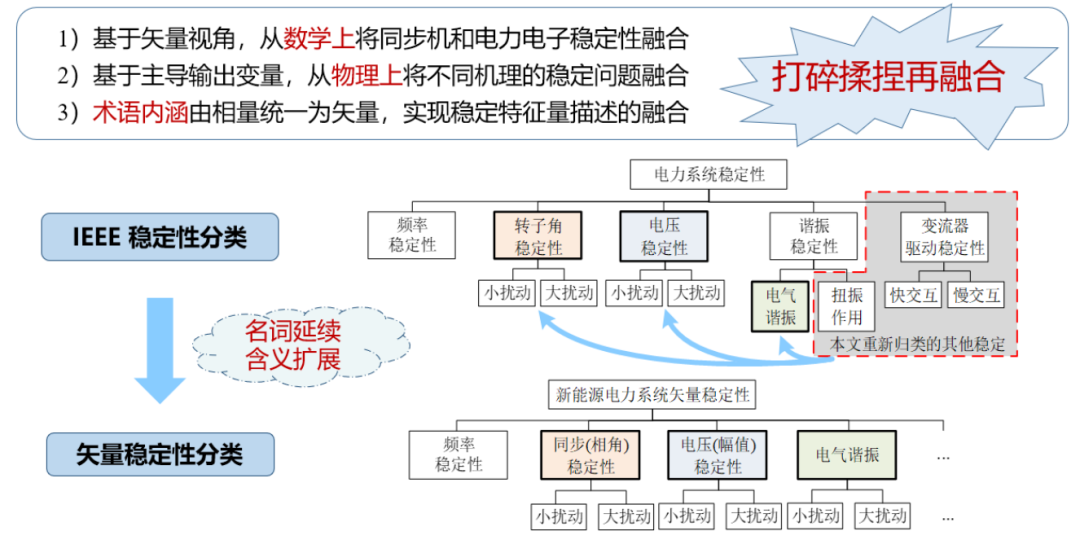相位角解析:揭秘电力系统稳定性的核心秘密
发布时间: 2024-07-09 08:15:01 阅读量: 258 订阅数: 35 


# 1. 电力系统稳定性的概念和重要性
电力系统稳定性是指电力系统在受到扰动时,能够保持电压、频率和相位角等电气参数在允许范围内变化,并最终恢复到稳定状态的能力。电力系统稳定性对于保证电网安全可靠运行至关重要。
电力系统稳定性主要分为三类:暂态稳定性、小信号稳定性和电压稳定性。暂态稳定性是指系统在受到大扰动(如短路、发电机故障等)时,能够保持稳定运行的能力。小信号稳定性是指系统在受到小扰动时,能够保持稳定运行的能力。电压稳定性是指系统在受到电压扰动时,能够保持电压稳定运行的能力。
电力系统稳定性受到多种因素的影响,包括发电机容量、负荷特性、线路阻抗、调速系统和保护装置等。因此,在电力系统规划和运行中,需要对电力系统稳定性进行分析和评估,以确保电网安全稳定运行。
# 2. 相位角分析的基础理论
### 2.1 相位角的定义和计算
相位角是衡量电力系统中不同节点之间电压相位差的一个指标。它通常以度为单位表示,表示为两个节点电压相位之间的差值。
相位角的计算公式为:
```
φ = arctan(V2sinθ2 - V1sinθ1 / V2cosθ2 - V1cosθ1)
```
其中:
* φ:相位角
* V1:节点1的电压幅值
* V2:节点2的电压幅值
* θ1:节点1的电压相位角
* θ2:节点2的电压相位角
### 2.2 相位角稳定性的影响因素
相位角稳定性受多种因素影响,包括:
* **线路阻抗:**线路阻抗越大,相位角差越大。
* **负载特性:**感性负载会导致相位角滞后,而容性负载会导致相位角超前。
* **发电机特性:**发电机的励磁系统和转动惯量会影响相位角的动态响应。
* **系统拓扑结构:**系统中环路和并联线路的数量会影响相位角的分布。
* **扰动:**系统故障、负荷变化或发电机故障等扰动会引起相位角的瞬态变化。
### 2.3 相位角稳定性的评估方法
评估相位角稳定性的方法主要有:
* **稳态相位角分析:**分析系统在稳态运行条件下的相位角分布,确定是否存在相位角过大的情况。
* **动态相位角分析:**模拟系统在扰动条件下的相位角变化,评估系统是否能够保持稳定。
* **相位角裕度分析:**计算系统相位角裕度,即系统在保持稳定之前相位角可以增加的最大值。
# 3.1 相位角裕度的计算和分析
相位角裕度是衡量电力系统稳定性的重要指标,它表示系统在发生扰动时,相位角偏离稳定点的最大允许范围。相位角裕度的计算和分析是相位角分析在电力系统稳定性评估中的关键环节。
#### 相位角裕度的计算
相位角裕度的计算方法有多种,常见的方法包括:
- **等效电路法:**将电力系统简化为等效电路,通过求解等效电路的相位角方程来计算相位角裕度。
- **潮流法:**利用潮流计算软件,在不同工况下计算系统各节点的相位角,并根据相位角差值来计算相位角裕度。
- **直接法:**直接测量系统中各节点的相位角,并根据相位角差值来计算相位角裕度。
#### 相位角裕度的分析
计算出相位角裕度后,需要对其进行分析,评估系统的稳定性水平。相位角裕度的分析主要包括以下几个方面:
- **裕度大小:**相位角裕度越大,系统的稳定性越好。一般来说,相位角裕度应大于30°,以确保系统在发生扰动时有足够的稳定裕度。
- **裕度变化:**相位角裕度会随着系统工况的变化而变化。分析相位角裕度的变化趋势,可以判断系统稳定性的变化情况。
- **裕度分布:**不同区域的相位角裕度可能不同。分析相位角裕度的分布情况,可以找出系统中薄弱环节,并采取针对性的措施提高稳定性。
#### 代码示例
```python
import numpy as np
import pandas as pd
from powerfactory import *
# 读取电力系统数据
net = Application.GetActiveProject()
net.LoadDiagram('system.pwb')
# 计算潮流
net.RunLoadflow()
# 获取各节点的相位角
phases = []
for bus in net.GetElements('*.ElmBus'):
phases.append(bus.GetAttribute('m:a'))
# 计算相位角裕度
裕度 = np.min(phases) - np.max(phases)
print('相位角裕度:', 裕度)
```
**代码逻辑分析:**
* 导入必要的库和模块。
* 读取电力系统数据。
* 运行潮流计算。
* 获取各节点的相位角。
* 计算相位角裕度。
* 输出相位角裕度。
#### 参数说明
* `net`:电力系统网络对象。
* `phases`:各节点的相位角列表。
* `裕度`:相位角裕度。
# 4. 相位角分析在电力系统规划和运行中的实践
### 4.1 相位角分析在电力系统规划中的应用
#### 4.1.1 新建线路和设备的规划
在电力系统规划阶段,相位角分析可用于评估新建线路和设备对系统稳定性的影响。通过模拟不同线路和设备的接入情况,可以计算相位角裕度,评估系统稳定性风险。
#### 4.1.2 系统稳定性裕度的评估
相位角分析还可以用于评估电力系统的稳定性裕度。通过计算系统在不同工况下的相位角裕度,可以确定系统稳定性的极限条件,为规划和运行提供决策依据。
### 4.2 相位角分析在电力系统运行中的应用
#### 4.2.1 实时相位角监测和预警
在电力系统运行中,实时相位角监测和预警至关重要。通过安装相位角监测装置,可以实时监测系统相位角的变化,当相位角接近临界值时,发出预警信号,为调度人员采取措施提供预警时间。
#### 4.2.2 紧急情况下相位角稳定性控制
在紧急情况下,如线路故障、发电机失步等,相位角分析可用于快速评估系统稳定性,并指导调度人员采取相位角稳定性控制措施,如紧急调频、调压、切负荷等。
### 代码示例
**新建线路和设备的规划**
```python
import numpy as np
import pandas as pd
# 输入数据
line_data = pd.read_csv('line_data.csv')
gen_data = pd.read_csv('gen_data.csv')
load_data = pd.read_csv('load_data.csv')
# 计算相位角裕度
phase_angle_margin = calculate_phase_angle_margin(line_data, gen_data, load_data)
# 评估系统稳定性风险
if phase_angle_margin < 0:
print('系统稳定性存在风险')
else:
print('系统稳定性满足要求')
```
**实时相位角监测和预警**
```python
import socket
import time
# 创建UDP套接字
sock = socket.socket(socket.AF_INET, socket.SOCK_DGRAM)
# 绑定套接字
sock.bind(('127.0.0.1', 5000))
while True:
# 接收数据
data, addr = sock.recvfrom(1024)
# 解析数据
phase_angle = float(data.decode())
# 评估相位角
if phase_angle > 45:
print('相位角接近临界值,发出预警')
```
**紧急情况下相位角稳定性控制**
```python
import numpy as np
import pandas as pd
# 输入数据
line_data = pd.read_csv('line_data.csv')
gen_data = pd.read_csv('gen_data.csv')
load_data = pd.read_csv('load_data.csv')
# 计算相位角裕度
phase_angle_margin = calculate_phase_angle_margin(line_data, gen_data, load_data)
# 评估系统稳定性
if phase_angle_margin < 0:
# 采取相位角稳定性控制措施
control_measures = ['紧急调频', '调压', '切负荷']
for measure in control_measures:
apply_control_measure(measure)
```
### 流程图
**相位角分析在电力系统规划中的应用流程图**
```mermaid
graph LR
subgraph 新建线路和设备的规划
A[新建线路或设备] --> B[相位角分析] --> C[评估系统稳定性]
end
subgraph 系统稳定性裕度的评估
D[系统工况变化] --> E[相位角分析] --> F[评估稳定性裕度]
end
```
**相位角分析在电力系统运行中的应用流程图**
```mermaid
graph LR
subgraph 实时相位角监测和预警
A[实时相位角监测] --> B[评估相位角] --> C[发出预警]
end
subgraph 紧急情况下相位角稳定性控制
D[紧急情况发生] --> E[相位角分析] --> F[评估系统稳定性] --> G[采取控制措施]
end
```
# 5. 相位角分析的未来发展和趋势
相位角分析作为电力系统稳定性评估的重要工具,随着电力系统的发展,也在不断地更新和完善,呈现出以下几个发展趋势:
### 5.1 相位角分析在分布式能源中的应用
分布式能源的接入对电力系统的稳定性提出了新的挑战。相位角分析可以应用于分布式能源的规划和运行中,以评估分布式能源对系统相位角稳定性的影响,并制定相应的控制措施。
### 5.2 相位角分析与人工智能的结合
人工智能技术的发展为相位角分析提供了新的机遇。通过将人工智能算法与相位角分析相结合,可以实现实时相位角监测、预警和控制,提高电力系统的稳定性水平。
### 5.3 相位角分析在微电网中的应用
微电网是一种分布式发电系统,相位角稳定性是其安全运行的关键因素。相位角分析可以应用于微电网的规划和运行中,以评估微电网的相位角稳定性,并制定相应的控制策略。
0
0





